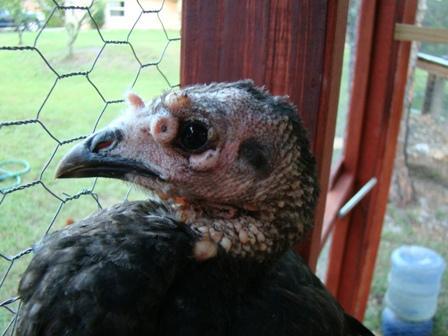I posted this picture a few days back, but no replies. Things have gotten worse since it was taken, with the bumps continuing to grow, and I believe that very soon her vision will be compromised. Does anyone know what this is and what I can do about it??

Her name is Anita. She was given to me by a friend at approximately 4-8 weeks of age. She must be in the range of 12 weeks now, but I might be way off on that. She is free-range on 1 1/2 acres by day and stays in a dry, well-ventilated coop by night with her brother and 7 young chickens of similar age. She gets standard poultry feed and fresh water daily. Coop has dirt floor with wood shavings (beginning of Deep Litter Method). The coop also contains an enclosed area with some straw "nests" for the chicken's eventual egg-laying, but she never really goes in that part.
None of the other birds have anything like this, though her brother does have some bigger bumps on his neck where it is all bumpy anyway, so I'm not sure if those are out of the norm.
Please advise.
Thank You!
Stacy (and Anita and Edward, the turkeys)

Her name is Anita. She was given to me by a friend at approximately 4-8 weeks of age. She must be in the range of 12 weeks now, but I might be way off on that. She is free-range on 1 1/2 acres by day and stays in a dry, well-ventilated coop by night with her brother and 7 young chickens of similar age. She gets standard poultry feed and fresh water daily. Coop has dirt floor with wood shavings (beginning of Deep Litter Method). The coop also contains an enclosed area with some straw "nests" for the chicken's eventual egg-laying, but she never really goes in that part.
None of the other birds have anything like this, though her brother does have some bigger bumps on his neck where it is all bumpy anyway, so I'm not sure if those are out of the norm.
Please advise.
Thank You!
Stacy (and Anita and Edward, the turkeys)

